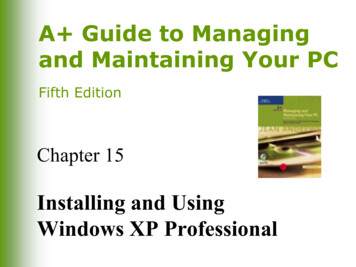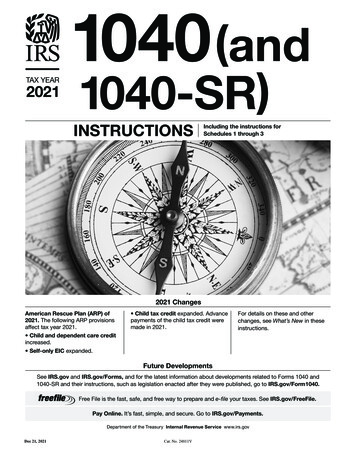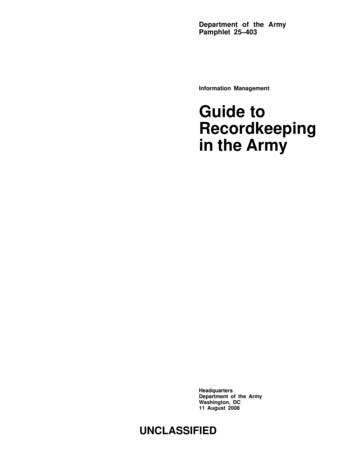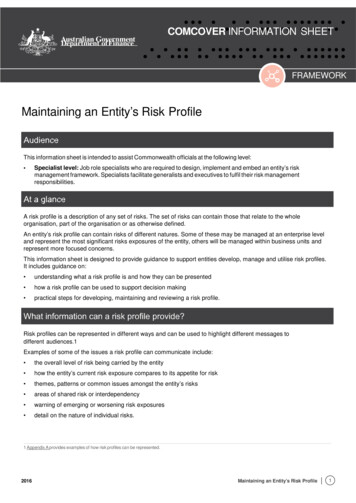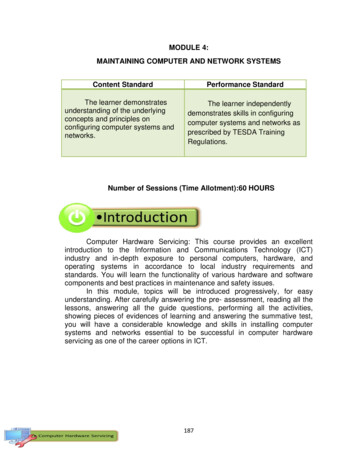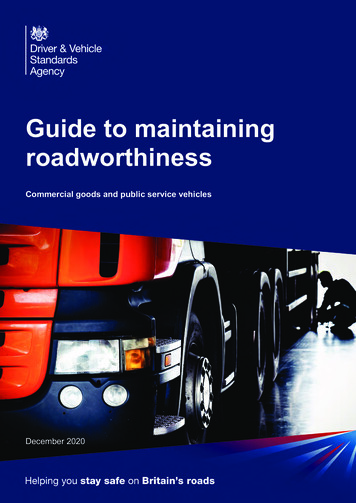
Transcription
Guide to maintainingroadworthinessCommercial goods and public service vehiclesDecember 2020
Produced by the Department for Transport in partnership with the transport industry Crown copyright 2020You may reuse this publication (not including logos and photographs) free of charge in anyformat or medium, under the terms of the Open Government Licence v3.0.To view this licence visit cence; orwrite to the Information Policy Team, The National Archives, Kew, Richmond, Surrey, TW94DU; or email: psi@nationalarchives.gsi.gov.uk.This publication is also available on our website taining-roadworthinessAny enquiries about this publication should be sent to us atenquiries@dvsa.gov.uk.
Guide to maintaining roadworthinessCommercial goods and passenger carrying vehicles
Helping you stay safe on Britain's roadsContentsForeword by the DVSA Chief Executive6Foreword by the Traffic Commissioners 81.1.11.21.31.4Introduction 10About this guide 10What this guide contains 14Getting it right 15Key points of a good maintenance system162.Responsibilities for roadworthiness 192.1 Roadworthiness inspections 213.Daily walkaround checks 23263.1 A system of reporting and recording faults3.2 Drivers’ responsibilities 293.3 Traction services and third party trailers304.Regular safety inspections and first use inspection354.1 Inspection scope and content 354.2 First use inspection 364.3 Safety inspection intervals 384.4 Case studies 444.5 Safety inspection report forms 464.6 Intermediate safety checks 484.7 Ad hoc safety inspection intervals 484.8 Electronic capture and storage of safety inspection data494.9 Safety inspectors 564.10 Use of assistants 564.11 Authority to remove or reinstate a vehicle564.12 Vehicle cleanliness 574.13 Duties of staff 575.Safety inspection and repair facilities58Safety inspection facilities 60Tyre management 62Brake performance assessment 63Accessibility (PSV) 68Contracted out arrangements 715.15.25.35.45.54 of 112
Guide to maintaining roadworthiness5.6 Drawing up a contract 715.7 Contract limitations 735.8 Visiting agents 745.9 Roadside safety inspections 745.10 Planning a safety inspection programme 756.6.16.26.36.46.56.6Monitoring 77Monitoring of drivers daily checks 78Annual test results 79Operator compliance risk score 80British standards 81Vehicle safety recalls 81DVSA earned recognition scheme 82Annexes1.Enforcement of the operator licensing scheme2.Where to get additional help90Technical support 90Training 90Saving fuel and protecting the environment91Fault finding 91Publications 912.12.22.32.42.5863A.Example of a driver’s vehicle defect report (goods vehicles)923B.Example of a driver’s vehicle defect report (passenger vehicles)934A.Example of a safety inspection record (HGV)944B.Example of a safety inspection record (PSV)985.Example of a maintenance agreement 1026.Specimen maintenance planner 1047.Useful addresses 1068.HGV drivers walkaround check 1089.PSV drivers walkaround check 1105 of 112
Helping you stay safe on Britain's roadsForeword by the DVSA ChiefExecutiveGareth Llewellyn, DVSA Chief ExecutiveWelcome to the latest edition of DVSA’s guide to maintaining roadworthiness.DVSA’s vision is for safer drivers, safer vehicles and safer journeys for all. Animportant way in which we will achieve this is by helping you keep your vehiclesafe to drive. Whether you operate a large fleet or just one vehicle, keeping yourvehicles in a roadworthy condition is good for business, good for the environmentand helps you stay safe on Britain’s roads.This guide provides you with best practice advice on the responsibilities thatan operator or driver has to ensure the roadworthiness of their vehicles. It alsocovers what you are legally required to do and gives information on where to seekadditional help, including technical assistance or training.To help raise vehicle standards, DVSA will make sure the required standards areclear and easy to understand; tests will keep up with new technology in vehicles,and testers and test centres who don’t test to the right standards will be helped6 of 112
Guide to maintaining roadworthinessto improve. We will also provide accessible, up-to-date information about whena vehicle needs to be checked and fixed because of a safety recall.We have also introduced an ‘earned recognition’ scheme for operators witha strong track record of compliance and adherence to standards. Thosequalifying for the scheme will see commercial and financial benefits as weleave them to go about their business unhindered. This will enable us todirect our enforcement activities at the serially and seriously non-compliant.Qualification for this scheme is entirely based on merit, and so I encourage youto read through this guide, work to the principles it sets out and aim for ‘earnedrecognition.’Gareth LlewellynDVSA Chief Executive7 of 112
Helping you stay safe on Britain's roadsForeword by the Traffic CommissionersSarah BellKevin RooneyAs an operator, transport manager, driver or technician, you know just how quickly vehicletechnology continues to progress. That’s why it’s vital for this essential guide to be regularlyupdated.We’re pleased to have worked with DVSA and with those who operate and maintaincommercial vehicles to produce the latest version of the Guide to MaintainingRoadworthiness. This ongoing collaborative working ensures that the information isinformed, relevant and up-to-date. You will find references to new approaches such aselectronic brake performance monitoring which can remove some of the challenges aroundroller brake testing of trailers.On safety inspection intervals, this edition of the guide no longer features the graph ofmileage vs inspection frequency. We strongly encourage you to take a proactive, evidencebased approach to setting inspection frequencies. You know your vehicles and youroperations better than anyone. Six weekly is a good starting point for many operators, butthis should be regularly reviewed based on the results of inspections and the performance ofyour vehicles. Listening to operators, we learned that some of you felt that the graph was toorigid and didn’t encourage basing intervals on the reality of operations.8 of 112
Guide to maintaining roadworthinessWe also acknowledge the development of technology in helping you with youroperator licence responsibilities. Smartphone apps, for example, now assistwith driver defect reporting. DVSA still finds that between a third and a half of allprohibitable defects it finds at the roadside could have been prevented by the driverconducting an effective walkaround check. Undertaking an effective walkaroundcheck, acting on what is found and recording that action is as much a part of adriver’s duties as steering the vehicle down the road. Failure to do so puts bothdrivers’ and operators’ licences in jeopardy.This edition of the guide will be launched alongside DVSA’s earned recognitionscheme. The scheme’s introduction has led to the development of a range of newcompliance management tools available to all operators and transport managers.Whether you seek accreditation or not, your operation could still benefit from usingthese tools.As before, nothing in this guide is mandatory but, by following it, you’ll ensurethat you meet the relevant conditions and undertakings on your licence. If yourmaintenance contractor recommends a different approach, it is for you to satisfyyourself that you will still meet the standards. These are the commitments youmade when you first applied for your licence.Sarah Bell Kevin RooneyLead Traffic Commissioners Enforcement9 of 112
Helping you stay safe on Britain's roads1. Introduction1.1About this guideThe Driver and Vehicle Standards Agency (DVSA) has produced this guide toexplain the responsibilities and systems involved in maintaining vehicles in aroadworthy condition, regardless of operating conditions, fleet size or vehicletype. The procedures and systems explained in this guide are useful for operators,drivers and all those who are responsible for operating, maintaining or providingcommercial goods and passenger carrying vehicles. The general principlesapply equally to light goods and passenger vehicles below the operator licensingthresholds and for vehicles that are otherwise exempt.Best practiceIt is not enough to rely on a maintenance system alone, because this cannot ensurethat vehicles are roadworthy. To ensure best practice, you will need to combinegood quality maintenance practices and skills with supervision and effectivemanagement of the system.New vehicle operatorsIf you are a new operator, you will find practical advice on how to devise, install andmonitor a system for ensuring roadworthiness. If you follow the advice given in thisguide, you can make sure you are complying with the law and that your compliancecan be monitored and controlled.Experienced vehicle operatorsIf you are an established or experienced vehicle operator, you will be able touse this guide as a benchmark to assess whether your systems are sufficientlycomprehensive or should be reviewed and improved in order to maintaincompliance. This guidance applies to you whether you carry out your ownmaintenance, contract out maintenance or do a combination of both. DVSA do notspecifically define a new or experienced vehicle operator because what constitutesan experienced operator could vary.10 of 112
Helping you stay safe on Britain's roads12 of 112
Guide to maintaining roadworthinessHowever, we do make suggestions as to what could make an experienced operator: If you have been trading under this licence or a previous licence for more thanthree years If you have been trading under this licence for more than 1 year, and you havebeen visited by a DVSA inspector and been approved as satisfactory If your company has been trading under this licence for a length of time suchthat you can prove that your roadworthiness process is effective and fullyestablished If you can demonstrate suitable evidence proving your experience whenquestioned by DVSA or the Traffic Commissioner. This could be a combinationof staff experience and skills, maintenance procedure experience andsubstantial defect reports/dataMaintaining ComplianceWe recognise that there are different methods and systems from those that are describedwithin this guide that can result in vehicles being maintained in a roadworthy condition.If you are an operator who wishes to adopt different systems, you must still satisfyTraffic Commissioners that the system you use is effective. Traffic Commissioners willonly agree to variations that will not reduce the control necessary to ensure satisfactorymaintenance.There must be a firm management commitment to review and improve maintenancesystems where defects are found on vehicles or when the fleet size or the natureof the business is changing. As a licensed operator, you can also be assured thatthe maintenance systems described in this guide will be accepted by the TrafficCommissioners, provided that the resulting condition of your vehicles remainsatisfactory. If this is not the case, however, Traffic Commissioners reserve theright to require more stringent arrangements from you (eg shorter periods betweeninspections), and the competence of the persons who carry out safety checks maybe challenged. The ultimate test will be whether a vehicle is, in fact, roadworthy.13 of 112
Helping you stay safe on Britain's roads1.2 What this guide containsThe procedures and systems described in this guide relate to responsibilities forroadworthiness, the different types of inspections, inspection intervals, data storage,inspection facilities, planner updates and essential reviews. This guide includes manyreferences to written maintenance records; however, using an electronic vehiclemaintenance system can provide effective management of all relevant data includingsafety inspections, maintenance scheduling and driver defect reporting. Keep in mindthat as a general principle computer records are acceptable, provided that they containthe essential information that can be made available for examination. For furtherinformation, see section four.Other guidanceIt is also important to note that this guide is only concerned with systems of maintenancefor roadworthiness. If you are looking for the maintenance of vehicles to achieveeconomy and reliability, we advise you to seek help from vehicle manufacturers, theiragents or the relevant trade organisations. You can find more information on sources offurther help and advice in Annex 2.14 of 112
Guide to maintaining roadworthiness1.3 Getting it rightDVSA recognises that operators of heavy goods or passenger carrying vehicles will notget everything right all the time. However, we do want you to be vigilant and responsible.The penalties for and consequences of non-compliance to you the operator and/or driver– and to the general public – can range from the inconvenient to the very serious and,sometimes, to the catastrophic. You and your staff may be fined or prosecuted, and yourvehicles may be prohibited. At worst, you may cause serious injury or fatalities becauseof badly maintained vehicles.15 of 112
Helping you stay safe on Britain's roads1.4 Key points of a good maintenance systemUse these important key points as a guide to help you plan and set up a compliant andeffective maintenance system for your vehicles.1. A driver or responsible person must undertake a daily walkaround check,preferably immediately before a vehicle is used.2. First use inspections are essential for operators who lease, hire or borrowvehicles. These are especially important where vehicles and trailers have beenoff the road for some time.3. Drivers must report promptly any defects or symptoms of defects that couldadversely affect the safe operation of vehicles. Reports must be recorded andprovision should be made to record details of any rectification work done.4. Drivers’ defect reports used to record any faults and rectification work must bekept for at least 15 months.5. Operators must ensure that safety inspections are carried out at thestated frequency.6. Safety inspections must include those items covered by theappropriate statutory annual test.7. Safety inspections should be pre-planned, preferably using atime-based programme.8. The system of safety inspections must be regularly monitored, especiallyin the early stages.9. Any remedial work carried out as a result of safety inspections must berecorded.10. The safety inspection record must include: name of owner/operator date of inspection vehicle identity (registration mark/trailer number) make and model odometer (mileage recorder) reading, if appropriate a list of all the manual items to be inspected details of any defects name of inspector full details of any repair work and who did it a signed declaration that any defects have been repaired satisfactorilyand the vehicle is now in a safe roadworthy condition.11. On certain types of vehicles and for some operations, intermediate safety16 of 112
Guide to maintaining roadworthinesschecks may be necessary.12. Records of safety inspections must be kept for at least 15 months forall vehicles, including vehicle/s that have been removed from theoperator licence.13. Staff carrying out safety inspections must be competent to assess thesignificance of defects. Assistance must be available to support thesafety inspection process.14. There must be an internal system to ensure that unroadworthy vehiclesare removed from service, with someone responsible for taking vehiclesoff the road.15. Operators who undertake their own safety inspections must have thecorrect tools and facilities for the size of the fleet and type of vehicleoperated.16. All operators should have access to a means of measuring brakeefficiency and setting headlamp aim. For vehicles showing signs ofvisible exhaust smoke, a diesel smoke meter should be used to ensurethat the level of smoke emission is within the legal requirements.17. Operators are responsible for the condition of vehicles and trailersthat are inspected and/or maintained for them by agents, contractorsor hire companies.18. Operators who have contracted out their safety inspections must drawup a formal written contract with an inspection agency or garage, andthis must be retained on file. Such operators should view inspectionrecords and have a means of regularly monitoring the quality of workproduced for them.19. The dates when safety inspections are due must be the subjectof forward-planning.20. A maintenance scheduling system, planner or wall chart should beused to identify inspection dates at least six months for manual systemsor can be dynamic for electronic systems.21. Any system of maintaining roadworthiness of vehicles should beeffectively and continually monitored.22. Any changes by licensed operators to arrangements for safetyinspections must be updated on the vehicle operator licensing system(VOL).23. Drivers must be adequately trained and given clear written instructionsabout their responsibilities.17 of 112
Helping you stay safe on Britain's roads18 of 112
Guide to maintaining roadworthiness2. Responsibilities for roadworthinessThis section gives best practice advice on the responsibilities that an operator ordriver will have to undertake to ensure the roadworthiness of their vehicle. It coverswhat you are legally required to do according to the law.As a user of vehicles, it is your responsibility to ensure that the vehicles you use areroadworthy. It is an offence to use an unroadworthy vehicle on the road. The term‘user’ of a vehicle applies to the driver and the person paying the driver to act forthem.LegislationIf you are an operator of heavy goods vehicles (HGVs) and public service vehicles(PSVs), you must meet the governing legislation that the Traffic Commissionershave outlined in their Statutory Guidance Document. This is now in legislation,so if you operate within the UK or outside of the UK, you should ensure vehiclesare roadworthy.Operators must comply with the declaration they give to the relevant trafficcommissioner that they will ensure that their vehicles are operated in a fitand serviceable condition. If operators intend making any change to theirmaintenance arrangements, they must update the details on the vehicleoperator licensing system.19 of 112
Helping you stay safe on Britain's roadsHire, loan or lease vehiclesThe vehicle itself may either belong to the user or be in their possession under anyagreement for hire, hire purchase, loan or lease. The user of a towing vehicle isresponsible for the roadworthiness of a trailer even if it does not belong to themForeign trailersIf foreign trailers are used then the user is responsible for the roadworthiness interms of condition but also in terms of the technical design of the trailer.Traffic commissioners require that all vehicles be maintained in a fit andserviceable condition when operated under an operator’s licence. DVSA’sexaminers support traffic commissioners by providing assessments of theeffectiveness of operator’s systems in meeting this requirement. We will,therefore, focus on the levels of compliance and standards of roadworthinessrather than how operators achieve the high standards expected. This providesoperators with considerable freedom to tailor their systems to the needs oftheir business.20 of 112
Guide to maintaining roadworthiness2.1 Roadworthiness inspectionsWhen it comes to ensuring the roadworthiness of a vehicle, there are two types ofessential inspections – which differ in scope and depth. Each type is used for a differentpurpose and requires different levels of skill to be carried out effectively.The two types of inspection are: daily walkaround checks first use inspections/regular safety inspections.An inspection should not be confused with a service. A service contains items requiringroutine maintenance, usually determined in scope and frequency by the vehicle’s usageand the recommendations of the vehicle’s manufacturer.21 of 112
Helping you stay safe on Britain's roads22 of 112
Guide to maintaining roadworthiness3. Daily walkaround checksThis section looks at the daily walkaround check. It offers best practice advice onsetting up a system for reporting faults and looks at defect reports, while clearlystating your legal position.A driver or responsible person must undertake a daily walkaround check before avehicle is used. As a driver, DVSA recommend this check is carried out before youfirst drive the vehicle on the road each day.Where more than one driver will use the vehicle during the day's running, the drivertaking charge of a vehicle should make sure it is roadworthy and safe to driveby carrying out their own walkaround check; however, due to health and safetyimplications this may not be practical on all occasions.An example of a system for managing in-service driver changes is where awalkaround check is carried out by a responsible person, and the drivers monitorthe vehicle during the day's running. When there is a change in driver duringthe day, it is sometimes unsafe to carry out a walkaround check, for exampleat a bus stop. This will be considered acceptable where there is a robust driverdefect reporting system in place, which details the initial walkaround check andany defects or ‘nil’ defects reported during the day for the various drivers of thatparticular vehicle.23 of 112
Helping you stay safe on Britain's roadsThe driver is always legally responsible for the condition of the vehicle while inuse. Therefore, conducting a daily walkaround check is a vital part of a driver’score role. Operators can delegate the walkaround check to a responsibleperson, who must carry out a minimum of one check in 24 hours.The check should cover the whole vehicle or combination. On multi-traileroperations, a check should be made on each trailer being used. The check shouldcover interior and exterior items that can be safely assessed without necessarily theuse of a workshop [see Annex 8 for walkaround check items].Assistance may be required at some time during the check, for example, to see thatlights are working. Alternatively, a brake pedal application tool may be used as aneffective way of making sure stop lamps are working, and that the braking systemis free of leaks. In addition, a torch, panel lock key or other equipment may beneeded.It could be beneficial to incorporate a post use check, to save downtime.It is important that drivers are aware of the overall vehicle dimensions, includingtrailer and load. High vehicles should display an in-cab overall height indicator. It isalso important to consider route planning before starting your journey if low bridgesneed to be avoided.24 of 112
Guide to maintaining roadworthiness25 of 112
Helping you stay safe on Britain's roads3.1 A system of reporting and recording defectsThere must be a system of reporting and recording defects that may affect theroadworthiness of the vehicle. This must include how they were rectified beforethe vehicle is used. Daily defect checks are vital, and the results of suchchecks must be recorded as part of the maintenance system. It is importantthat enough time is allowed for the completion of walkaround checks and thatstaff are trained to carry them out thoroughly. Drivers should be made awarethat daily defect reporting is one of the critical elements of any effective vehicleroadworthiness system.Examples of how to perform a walkaround check can be found on YouTube underDVSA HGV or PSV driver’s daily walkaround checks.Drivers’ defect reportsAs the driver, you are legally responsible for the condition of your vehicle when inuse on the road.Drivers must report any defects, or symptoms of defects, that could prevent thesafe operation of the vehicles. In addition to daily walkaround checks, you mustmonitor the roadworthiness of your vehicle when being driven, and be alert to anyindication that the vehicle is developing a fault eg warning lights, vibrations or othersymptoms. When a vehicle is on site work, you should walk around the vehiclebefore leaving the site to identify any faults. If any safety defects are found, youmust not use the vehicle on the road until it is repaired.26 of 112
Guide to maintaining roadworthinessProviding a written reportAny defects found during the daily walkaround check, while the vehicle is in use oron its return to base, must be the subject of a written report by the driver or someother person responsible for recording defects.The details recorded should include: vehicle registration or identification mark date details of the defects or symptoms the reporter’s name who the defect was reported to assessment of the defect rectification work date rectification work was completed.It is also common practice to use a composite form that includes a list of the itemschecked each day. Where practicable the system should incorporate ‘nil’ reportingwhen each driver makes out a report sheet - or confirms by another means thata daily check has been carried out and no defects found. Electronic records ofreported defects are acceptable and must be available for 15 months, along withany record of repair.Appropriate actionAll drivers’ defect reports must be given to a responsible person with sufficientauthority to ensure that any appropriate action is taken. This might includetaking the vehicle out of service. Any report listing defects is part of thevehicle’s maintenance record and must be kept for at least 15 months, togetherwith details of the rectification work and repairer.It is good practice to have ‘nil’ defect reports as they are a useful means ofchecking that drivers are carrying out their duties and these forms can be usedfor audit purposes.A ‘nil’ defect reporting system demonstrates a check has been conducted and is apositive report that the vehicle is free from defects.If you are an owner-driver, you will probably not have anyone to report defects to,except your transport manager (if you have one). In these cases, defects and theremedial action taken can simply be recorded and held for at least 15 months.27 of 112
Helping you stay safe on Britain's roads28 of 112
Guide to maintaining roadworthiness3.2 Drivers’ responsibilitiesDrivers must be made aware of their legal responsibilities regarding vehiclecondition and the procedures for reporting defects. Operators must ensurethat all drivers are adequately trained to perform this function, and this maybe part of their driver’s certificate of professional competence training. Driver’sresponsibilities should be detailed in writing, describing defect reportingsystems as well as any other duties they are expected to perform. The drivershould sign to confirm they have received their responsibilities in writing andunderstand what is required. A copy of the document should be kept onfile. Drivers share the responsibility for the vehicle’s roadworthiness with theoperator. They may be fined or prosecuted for roadworthiness offences foundon vehicles if they are considered partly or wholly responsible.Minor repairs by driversIf you are an operator, you should bear in mind that drivers who are expected torepair minor defects in service would need appropriate training.Traffic commissioners can take action against a driver who fails to completean adequate walkaround check. This could lead to a driver conduct hearing,which may result in the loss of the vocational driving licence.29 of 112
Helping you stay safe on Britain's roads3.3 Traction services and third party trailersOperators can provide a traction-only service to customers who wish toown their own trailers for branding and loading purposes but do not wish tooperate vehicles to pull them. It is also common practice for an operator whomay own trailers but is also contracted to tow third party trailers not owned ormaintained by them.Ensuring third party trailer roadworthiness can be problematic for the tractionservice operator. Usually for short-term use the trailer owner would beresponsible for the routine maintenance of the trailer, including the safetyinspection (SI). Under these circumstances, traction operators are reliant onthe trailer owner to correctly carry out their own safety inspections within theirstated frequency and complete any necessary repairs.The traction operator is responsible for ensuring a thorough walkaroundcheck of the tractor/trailer combination is carried out to establish it is safeprior to use. If defects are identified during the walkaround check, theseshould be rectified prior to use.Traction operators would be expected to work with the trailer owners toensure any trailers operated fall within the owner's agreed SI frequency andthat they are roadworthy. It is best practice for the trailer owner to provideevidence for the operator that first use checks and safety inspectionshave been undertaken and demonstrate there are no outstanding defectsreported for the trailer. There must also be a robust system in place to ensuredefects identified during the walkaround check, or develop during use, arerecorded and rectified before the tractor/trailer combination is operated in anunroadworthy condition.30 of 112
Guide to maintaining roadworthiness31 of 112
Helping you stay safe on Britain's roads32 of 112
Guide to maintaining roadworthinessThe driver/operator bears the full responsibility for the safe operation androadworthiness of the tractor/trailer combinat
3. Daily walkaround checks 23 3.1 A system of reporting and recording faults 26 3.2 Drivers’ responsibilities 29 3.3 Traction services and third party trailers 30 4. Regular safety inspections and first use inspection 35 4.1 In
